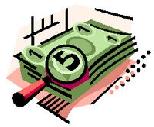
 |
|
| Financial Terms | |
| Current liability |
|
Information about financial, finance, business, accounting, payroll, inventory, investment, money, inventory control, stock trading, financial advisor, tax advisor, credit.
Main Page: financial, stock trading, investment, inventory, money, financial advisor, accounting, business, |
Definition of Current liability
Current liabilityThis is typically the accounts payable, short-term notes payable, and
Related Terms:Accounts payableAcurrent liability on the balance sheet, representing short-term obligations Asset/liability managementAlso called surplus management, the task of managing funds of a financial Contingent pension liabilityUnder ERISA, the firm is liable to the plan participants for up to 39% of the net Current accountNet flow of goods, services, and unilateral transactions (gifts) between countries. Current assetsValue of cash, accounts receivable, inventories, marketable securities and other assets that Current couponA bond selling at or close to par, that is, a bond with a coupon close to the yields currently Current liabilitiesAmount owed for salaries, interest, accounts payable and other debts due within 1 year.  Current issueIn Treasury securities, the most recently auctioned issue. Trading is more active in current Current maturitycurrent time to maturity on an outstanding debt instrument. Current rate methodUnder this currency translation method, all foreign currency balance-sheet and income Current ratioIndicator of short-term debt paying ability. Determined by dividing current assets by current Current yieldFor bonds or notes, the coupon rate divided by the market price of the bond. Current-coupon issuesRelated: Benchmark issues LiabilityA financial obligation, or the cash outlay that must be made at a specific time to satisfy the Liability funding strategiesInvestment strategies that select assets so that cash flows will equal or exceed Liability swapAn interest rate swap used to alter the cash flow characteristics of an institution's liabilities so  Limited liabilityLimitation of possible loss to what has already been invested. Limited-liability instrumentA security, such as a call option, in which the owner can only lose his initial Limited-liability instrumentA security, such as a call option, in which the owner can only lose his initial investment. Other current assetsValue of non-cash assets, including prepaid expenses and accounts receivable, due Unlimited liabilityFull liability for the debt and other obligations of a legal entity. The general partners of a Current assetsCash, things that will be converted into cash within a year (such as accounts receivable), and inventory. Current liabilitiesBills a company must pay within the next twelve months. Current ratioA ratio that shows how many times a company could pay its current debts if it used its current assets to pay them. The formula: Current assetsAmounts receivable by the business within a period of 12 months, including bank, debtors, inventory and prepayments. Current liabilitiesAmounts due and payable by the business within a period of 12 months, e.g. bank overdraft, creditors and accruals. current assetscurrent refers to cash and those assets that will be turned current liabilitiescurrent means that these liabilities require payment in current ratioCalculated to assess the short-term solvency, or debt-paying Current RatioA measure of the ability of a company to use its current assets to concurrent engineeringsee simultaneous engineering limited liability companyan organizational form that is a hybrid of the corporate and partnership organizational limited liability partnershipan organizational form that is a hybrid of the corporate and partnership organizational Current assetTypically the cash, accounts receivable, and inventory accounts on the Current costUnder target costing concepts, this is the cost that would be applied to a LiabilityA dollar amount of obligation payable to another entity. current yieldAnnual coupon payments divided by bond price. limited liabilityThe owners of the corporation are not personally responsible for its obligations. Current AccountThat part of the balance of payments accounts that records demands for and supplies of a currency arising from activities that affect current income, namely imports, exports, investment income payments such as interest and dividends, and transfers such as gifts, pensions, and foreign aid. Current DollarsA variable like GDP is measured in current dollars if each year's value is measured in prices prevailing during that year. In contrast, when measured in real or constant dollars, each year's value is measured in a base year's prices. Current YieldThe percentage return on a financial asset based on the current price of the asset, without reference to any expected change in the price of the asset. This contrasts with yield-to-maturity, for which the calculation includes expected price changes. See also yield. Current Tax Payment Act of 1943A federal Act requiring employers to withhold income taxes from employee pay. Contingent LiabilityAn obligation that is dependent on the occurrence or nonoccurrence of Current Income Tax ExpenseThat portion of the total income tax provision that is based on Deferred Tax LiabilityFuture tax obligation that results from the origination of a temporary LiabilityA probable future sacrifice of economic benefits arising from present obligations of Current AssetsCash and other company assets that can be readily turned into cash within one year. Current LiabilitiesDebts or other obligations coming due within a year. Current Ratiocurrent assets divided by current liabilities. This ratio indicates the extent to which the claims of short-term creditors are covered by assets expected to be converted to cash in the near future. Net book valueThe current book value of an asset or liability; that is, its original book value net of any Fair ValueThe amount at which an asset could be purchased or sold or a liability incurred or Related to : financial, finance, business, accounting, payroll, inventory, investment, money, inventory control, stock trading, financial advisor, tax advisor, credit. |